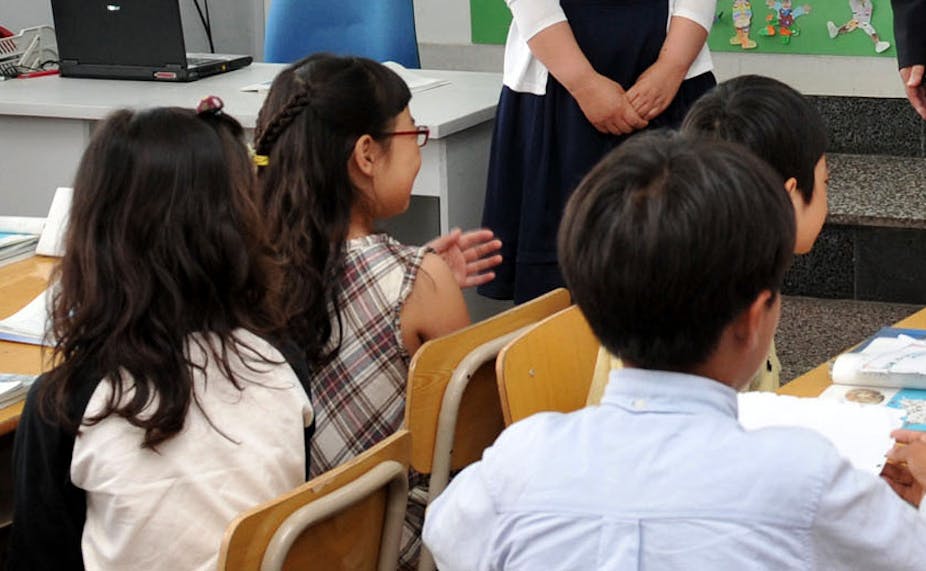In a pair of opinion pieces in The Australian last week, it was claimed that universities have incentive to “churn out poor-quality teachers through cheap education courses” and that there are six steps to getting “better teachers”.
The recent attention on initial teacher education is due to the release of the Teacher Education Ministerial Advisory Group’s (TEMAG) report in February. More recently, education think tank Learning First also released a report.
The focus of initial teacher education is on what we call “pre-service” learning, which is prior to registration as a practising teacher. With a growing population driving increased demand for new teachers, it is timely to focus on the provision of initial teacher education in Australia.
However, the argument about teacher quality taken up by the media is a distraction from real issues of equity and access for all Australian students, particularly those from disadvantaged backgrounds.
Contrary to what you might read in the papers, Australian universities do produce high-quality teaching graduates. Despite the rhetoric about low entrance scores and poor initial teacher education, this is not supported by the data on employment rates, graduate satisfaction and employer satisfaction.
What does initial teacher education look like in Australia?
There are more than 400 different initial teacher education programs on offer in Australia from 48 providers, ranging from the intensive Teach for Australia program to four-year Bachelor of Education degrees.
These programs are formally accredited by state government authorities (such as the Queensland College of Teachers) and the federal government’s Tertiary Education Quality and Standards Agency, as well as undergoing regular audits and institutional accreditation.
Also, all initial teacher education programs are required to align to the graduate teacher professional standards, developed by the Australian Institute for Teaching and School Leadership (AITSL) as part of a national approach to accreditation. It is a tightly regulated space.
Universities teach both practice and theory, where students learn about educational theories (from fields including sociology, psychology and philosophy) and engage in research-informed teaching and learning. Pre-service teachers are also provided with multiple opportunities to road-test their teaching repertoire through placements in schools and other educational organisations.
Accusations levelled against initial teacher education in the recent reports include a lack of evidence-based content, inadequate subject knowledge training, and limited professional practice.
The Learning First report presents Singapore’s 22-week professional practice in contrast to claims that Australian pre-service teachers do not spend enough time in schools, and in some cases, are expected to cold-call schools.
In Queensland, where I work, there is a mandated 80 days of placement in schools for Bachelor of Education students. At my university, there are actually 100 days of professional placement.
In The Australian, the following claims are made:
The initial teacher education teachers receive at university generally fails to provide them with essential skills. Teachers are thrown in front of a classroom and left to sink or swim. Some are excellent in spite of their teacher training, not because of it.
It is unclear where the evidence base is for such claims. For example, on the argument about lacking basic teaching methods, the Learning First report references the TEMAG report, which then references two further reports. There appears to be little, if any, link to empirical research evidence.
The Learning First report contains 45 references, of which only nine are research papers from peer-reviewed journals. The rest include a non-research mix of government reports, working papers and books. The TEMAG review had a similar emphasis on other reports, opinion pieces and non-research references.
Graduation is just the beginning
The Learning First report makes the following suggestion:
Consider changing teacher registration so that only those who can demonstrate they are effective teachers can qualify to be registered. A comprehensive assessment would mean that only a percentage of applicants – not all – would pass and be registered.
Given my earlier point that initial teacher education accreditation is linked to the graduate teacher standards, any additional pre-registration test of teaching effectiveness would be redundant.
A similar argument made for testing graduates’ literacy and numeracy skills is likely to have as little impact on judging whether they are ready for classroom teaching.
A recent UK review of teacher education emphasised the “initial” in initial teacher education, given that much learning actually takes place on the job.
As such, there is a need for better mentoring support for graduate and early-career teachers. This is shown clearly in the Staff in Australia’s Schools Survey, where early career teachers expressed a strong need for professional learning.
However, the current focus on initial teacher education as the be-all and end-all of teacher education ignores the importance of ongoing professional development. This should take place not only in the first years of teaching, but throughout teachers’ careers.
As a comparison, medicine graduates study at university for five or six years, then still need to undertake an internship of one year before being allowed to register for general practice. Most go on to undertake a further two to three years of residency before beginning specialist training.
Perhaps we should be taking our cue from medicine, and treating our graduate teachers in a similar manner to medical interns and residents. Learning to teach is a process that begins at universities, but continues for an entire career.

